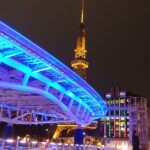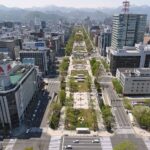The city’s public transportation system is both cost-effective and user-friendly in Salvador. The bus is the primary mode of public transportation; it operates on frequent routes across the city and its neighboring areas. In addition, there are ferry services and a metro system in Salvador, which is comprised of two lines that link the central business district with the eastern suburbs. Taxis are another option, however, their rates are typically higher than those of other modes of transportation. In addition, the municipality provides its residents with access to bike-sharing programs, which enable them to borrow bicycles for a charge. There are a large number of parking spaces and garages available for individuals who would rather travel by car. In conclusion, Salvador offers a wide array of options for public transportation that are not only economical but also handy.
Metro system in Salvador – Basic information
Getting to the city of Salvador is a breeze because of the efficient metro system. It is a cutting-edge and time-saving network, comprised of two lines that serve a combined total of 20 stations. The metro extends all the way from the city’s historic core out to the outskirts, and it has stops in all of the most important neighborhoods and points of interest. It’s a terrific method to travel around Salvador, and it’s a fast option that commuters can use that won’t break the bank.
The lines of the Salvador subway system
A rapid transit system that serves the city of Salvador, which is the capital of the state of Bahia and the fourth largest city in Brazil, is called the Salvador Metro. This system is also known as the Metrô de Salvador or the Sistema Metropolitano Salvador-Lauro de Freitas. The present network extends over a total distance of thirty-three kilometers and twenty, all of which are accessible to the general public. In addition to this, the system is designed to operate all the way into the center of the city of Lauro de Freitas. The CCR METR BAHIA Company is responsible for its day-to-day operations.
In addition, the city of Salvador is served by a railway line that has a meter gauge of 1,000 millimeters and is known as the Suburban Line (Calcada-Paripe). This line extends for 14 kilometers and passes through the suburbs of the city. There is no connection between this line and the Metro. This suburban route will soon be converted into a VLT line and connected to Salvador’s underground metro system, which is 43 kilometers in length.
The construction of the SMSL is being carried out in an expansion that is divided into six stages. This expansion will integrate the traditional center of the city until Pirajá (later, until the district of guas Claras, near Cajazeiras), and until the neighboring municipality of Lauro de Freitas through Line 1 and Line 2, respectively, for a combined total of 41.8 kilometers (17.6 of Line 1 and 24.2 of Line 2) and 22 stations.
The subway will serve as the main trunk system in Greater Salvador’s integrated transportation network, while the other modes of transportation will be complimentary and feeder systems. This will be accomplished as part of the efforts to develop integrated transportation. Therefore, in accordance with the requirement of integration that was included in the edict of the subway bidding in 2013, the subway is planned to coordinate with other related modes of transportation. These include the Suburb Train, which currently operates with 13.5 kilometers of extension and 10 stations and must be replaced by the SkyRail Bahia monorail line; the Blue Line and Red Line, which are transverse feeder roads that are currently being deployed to be covered by a Bus Rapid Transit System (BRT); and conventional Soter buses.
Map of Salvador Metro 2023 – Free Download in PDF

Click on the image and download the map of Salvador´s underground system for 2023
Anyone who needs assistance navigating the city should look no further than the Salvador Metro 2023 map for assistance. It is available for free download in PDF format, and it is simple to use and browse once it is opened. Because it is both extremely detailed and up-to-date, the map is an extremely helpful tool for tourists who are visiting the city. It provides information on all the stations, routes, and stops, in addition to details on the transportation services, connecting routes, and other amenities that are available. Using this map, tourists can simply plan their itineraries across Salvador, which makes it much simpler for them to navigate the city.
Public transport tickets in Salvador – Best types for travelers & actual prices
Visiting Salvador, Brazil? You might need to purchase tickets for public transportation. Fortunately, the city has a wide range of options for travelers to choose from. This article will provide a comprehensive overview of different tickets and their prices, so you can quickly and easily find the best option for your trip.
Ticket options for public transportation in Salvador include single-journey tickets, day tickets, and multiple-trip tickets. Single-journey tickets are the most basic option and cost around R$3.50. Day tickets allow travelers to ride multiple times throughout the day, and cost around R$8.50. Lastly, multiple-trip tickets (also known as “rechargeable cards”) allow travelers to purchase a certain number of trips in advance. These tickets are more cost-effective and range in price from R$10 to R$50.
In addition to the tickets mentioned above, Salvador also offers special tickets for tourists. These include a 3-day tourist passport, which allows travelers to take unlimited rides for three consecutive days. The price for this ticket is R$50.
When it comes to the best option for tourists visiting Salvador for three days, the 3-day tourist passport is the clear winner. For the same price as a single journey ticket, travelers can enjoy unlimited rides on all public transportation in the city. This is an especially great deal for those who plan to be using public transportation often throughout their stay.
Overall, there are a variety of tickets and prices available for public transportation in Salvador. Single journey tickets are the most basic option, while the 3-day tourist passport is the best choice for tourists who plan to stay in the city for a few days. With this overview of the different tickets and prices, travelers can quickly and easily find the best option for their trip.
Summary of fares for public transport in Salvador
- Tickets for a single travel cost approximately R$3.50.
- Day tickets cost approximately R$8.50.
- Multiple-ride tickets can be purchased for anywhere from R$10 and R$50.
- Special tourist passports that are valid for three days and cost R$50 offer unlimited rides during that time period.
Timetables & Schedules of Salvador Metro system
The hours of operation for the Salvador Metro are as follows: 5:00 AM to 11:00 PM (Monday through Saturday); 9:00 AM to 8:00 PM (Sundays and holidays); and 5:00 AM to 8:00 PM (public holidays). Trains depart between every five and ten minutes, depending on the time of day and the day of the week, depending on the distance between stations. During times of high demand, some lines may run as frequently as every three to four minutes. The hours of operation for the stations are as follows: Monday through Saturday, 4:30 am to 11:30 pm; Sunday and public holidays, 8:30 am to 8:30 pm. Tickets can be purchased by passengers at any stop or at authorized sales stations across the system. Tickets must be validated before boarding the train and can be used on any line that the company operates.
What Are Other Options For Public Transportation In Salvador?
The Brazilian city of Salvador is well-known for its thriving culture, lively streets, and well-developed public transportation system. The metro is the recommended method of transportation for moving around the city, and this applies to both tourists and locals alike. On the other hand, there are a number of different choices for public transportation in the region, some of which may provide a more practical or cost-effective means of getting around.
Taxis are a common mode of transportation in Salvador, and it’s not difficult to hail one when you need one. You can get a taxi by flagging one down on the street, calling one to come to you, or ordering one through an app on your smartphone. The vast majority of cabs have meters, and the fares are generally quite reasonable. Be aware, however, that some taxi drivers may require a little bit of persuasion before agreeing to take you to your destination; thus, you should be sure to have the address written down and ready to go before you get in the taxi.
Bus stations are many in Salvador, and taking the bus is one of the most convenient ways to get around the city. Although they are sometimes busy, buses are inexpensive to use and can take passengers to virtually any part of the city. Be aware that if you are not familiar with the city or its language, navigating the bus system may feel like a bit of a challenge.
Additionally, bicycles are gaining in popularity in Salvador, to the point where certain districts of the city have begun to implement bike-sharing schemes. Cycling through the city on two wheels is not only a fun way to get some exercise but also a terrific method to get around. Cyclists, on the other hand, are obligated to always protect their heads by donning helmets and should be mindful of the traffic in the city.
In conclusion, residents of Salvador have access to a variety of private automobile services, like Uber and 99, among others. These services provide a dependable and secure method of getting around the city, and they might be an excellent choice if you’re looking for a ride that’s a little more pleasant than the average taxi.
In Salvador, there is an abundant variety of public transportation alternatives available to meet any and all of your requirements. You will definitely be able to find a means to navigate the city, regardless of whether you are seeking a mode of transportation that is more convenient or one that is less expensive.
How To Get From Salvador International Airport (sal) To The City Center With Public Transport?
For those who are not familiar with the area, getting from the Salvador International Airport to the central business district of the city can be a challenging endeavor; nevertheless, if one is armed with the appropriate knowledge, the journey can be completed with ease. You will be relieved to know that there is an abundance of public transportation available to take you to and from the Salvador International Airport and the central business district.
The first choice is to take a cab, which is both the most practical and the quickest mode of transportation available for this trip. Outside of the airport, there is an abundance of taxis that are readily accessible to take passengers to their destinations. Depending on the amount of traffic, a taxi ride should take approximately 15 minutes and cost approximately R$60.
Taking the public bus is the second alternative available to you. However, depending on traffic, the trip could take up to an hour even though it is the most cost-effective way to get from the airport to the central business district. Simply leave the airport and walk to the bus station, which is located on the left side of the airport. This will allow you to enter the bus station. After that, you can make your way to the heart of the city with the Executive Bus route (Aeroporto-Lapinha). The bus leaves every 20 minutes, and the fare is R$4 per person.
The third choice is to use the Airport Shuttle, which is a shared van service that offers transports from the airport to central locations throughout the city. These transfers can be made from door to door. The shuttle service is available around the clock and may take as long as an hour to complete, depending on how busy the roads are. The price is R$20 for each individual participant.
The procedure of getting from the Salvador International Airport to the heart of the city is not overly complicated and may be accomplished in a number of different ways. Just remember to organize everything in advance and give yourself plenty of time to complete the trip.
What kind of sightseeing do you have to see if you visit Salvador for the first time?
The Salvador tourist destination is a lively and fascinating place to visit, with a wide range of sights and activities to discover and take pleasure in. In Salvador, there is something for everyone to enjoy, from the city’s magnificent beaches to its stunning architecture. When you are in Salvador, you shouldn’t miss out on seeing any of these major attractions:
The Historical Center of Salvador: The Historical Center of Salvador is an attraction that should not be missed because of its convenient location in the middle of the city. This neighborhood is home to several significant landmarks, such as the Catedral Baslica of Salvador, the Church of S. Francisco, and the Pelourinho. This region is also rich in cultural and historical landmarks, such as the Palace of the Governors, the Museum of Modern Art, and the Museum of Sacred Art.
Praia do Forte, also known simply as Praia do Forte, is a breathtaking beach that is found to the north of Salvador. This beach is well-known for its powdery white sand, crystal blue seas, and breathtaking views of the town that is located nearby. In addition, guests have access to a wide range of recreational opportunities, including swimming, snorkeling, kayaking, and many more.
The Barra Lighthouse is a well-known and historically significant structure in the Salvador area. This lighthouse was constructed in 1844, and it features breathtaking vistas over the city as well as the beaches that are located nearby. In addition, guests have the opportunity to investigate the local history in a museum that is conveniently located nearby.
Mercado Modelo is a popular marketplace in Salvador. This market is well-known for its lively environment, with sellers selling a wide range of goods, such as apparel, jewelry, and handcrafted items. In addition, this location offers a wide selection of delectable foods and beverages for guests to enjoy.
The Afro-Brazilian Museum, also known as the Museu Afro-Brasileiro, is widely regarded as one of the top tourist destinations in Salvador. The history, culture, and art of Brazil’s Afro-Brazilian population are the primary topics covered by this museum. The exhibitions provide guests with the opportunity to learn more about the people and the culture of Salvador via exploration.
These are just some of the most popular places of interest that tourists flock to in Salvador. There is something for everyone in Salvador, whether you’re seeking for beautiful beaches, fascinating cultural activities, or lively marketplaces. Make travel plans to this incredible location as soon as possible so you can experience everything it has to offer.
Summary of our tour guide for Salvador
The Brazilian city of Salvador, which is found on the country’s northeastern coast, is known for its vivid and colorful culture. It is the largest city in the state of Bahia, which it is the capital of, and it has a population of more than 3 million people. Buses, trams, and even a metro system are all part of Salvador’s well-oiled and very effective public transportation system. In addition, the city has a ferry service to the islands in the vicinity, and its taxi sector is thriving. In general, Salvador is a vibrant city that provides a wide variety of options for public transportation.
Top 5 FAQs and answers about Salvador public transport?
In Salvador, what kinds of public transportation are there to choose from?
- The city of Salvador offers a diverse selection of options for public transportation. Buses are the most typical and widespread mode of public transit, and they can be found in both urban and suburban settings. In addition, there is a light rail system in the city, which is an excellent and time-saving method for getting around the city. A network of ferries, which can be utilized to travel between the city’s several islands, is also made available by the city.
How much does it cost to ride public transit in Salvador?
- The fare for using Salvador’s public transportation varies widely depending on the mode of conveyance that one chooses. Buses in the city are typically the most cost-effective mode of public transportation, with rates beginning at as little as R$2.50. The fare for the light rail system begins at R$3.50 and is a little bit more expensive than the other transportation options. Fares begin at R$5.00 for the most expensive mode of transportation, which is the ferry system.
Does Salvador have any coupons or discounts for the city’s public transportation?
- In the event that you take public transportation in Salvador, you may qualify for one of the many discounts that are offered. boat, bus, and light rail fares can be discounted for senior citizens, students, and individuals with disabilities. Seniors can also ride for free on the boat. In addition, the city provides a fare card that can be used for a reduced price on any of the city’s public transportation options.
Is it risky to take public transportation in Salvador?
- It is true that Salvador’s public transportation is, for the most part, risk-free. However, just like in any other city, it is essential to be aware of your surroundings and to take appropriate safety measures in order to protect yourself. In addition, the city has taken a number of precautions to safeguard the safety of passengers, including increasing the number of security staff and installing surveillance cameras with closed-circuit television.
Is there an application that I may use to schedule my journeys using Salvador’s public transportation?
- There is, in fact, an application known as “Salvador on the Move” that can be utilized to organize journeys in Salvador using the public transportation system. Users are able to check arrival and departure times in real-time using the app, in addition to being able to plan routes, view timetables, and purchase tickets.







